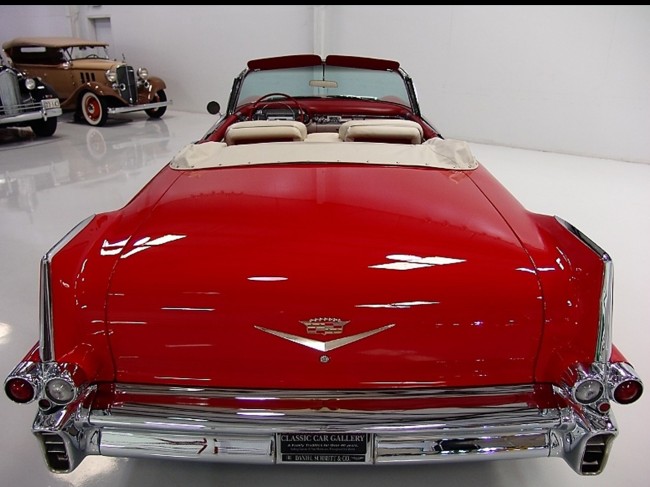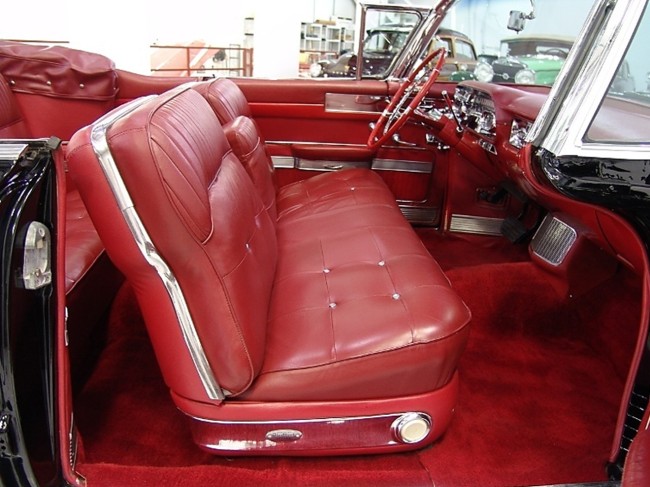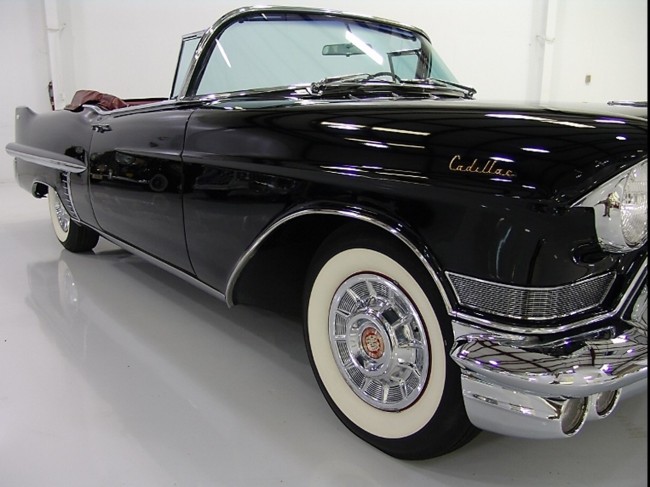1957 Cadillac Series Sixty-two Convertible
The quintessential status symbol…
…in the continuing saga of “As the Standard of the World Turns”
The Series Sixty-two was a model produced by Cadillac from 1940 through 1964 when it was renamed “Calais” for the 1965 model year. It was one of Cadillac’s most popular models. For the 1949 model year, the Series Sixty-two spawned the “Coupe deVille.”
For the 1953 model year the world was introduced to the very first Series Sixty-two Eldorado. The Series Sixty-two convertible was one of America’s most luxurious convertibles. Cadillac’s magnificent new design and craftsmanship were dramatically displayed in the 1957 Cadillac Series Sixty-two convertible.
Cadillac for the 1957 model year was completely redesigned. A Cadillac convertible was the celebrity among Cadillacs. There was no more gracious manner in which to enjoy open-air touring than the 1957 Series Sixty-two convertible. Its aristocratic flair was dramatic and pronounced.
Open-air splendor was the constant companion to the owner of this extremely gracious version of the Series Sixty-two models. The advanced features of engineering and construction provided the most satisfying performance and superb comfort ever achieved in the history of the brand. Here is another classic encore performance…in the continuing saga of “As the Standard of the World Turns.”
Apart from the Biarritz convertible, the Series Sixty-two convertible was the most elegant convertible built in the land. It was the synthesis of two motoring worlds; it had all the panache of a ragtop and the comfort of a luxury car. Style code #6267F Series Sixty-two convertible had a base price of $5,225. (Cadillac repairs today run up tabs along these same dollar amounts…amazing)
The 1957 Cadillacs were as rugged as they were rewarding. Take the vault-like door construction for example, it is formed from two panels of heavy gauge cold-rolled sheet steel that is formed into a rigid, self-reinforcing box-like assembly. The doors complete the “Ring of steel” which provided a steel safety skeleton surrounding the passenger compartment’s integrity.
A box-girder reinforced cowl and dash, integral rear quarter panels, and rear fender assembly completes this sturdy frame-work surrounding the driver and passengers. The improved panoramic windshield with pillar posts range of unobstructed visibility. The windshield and door glass used Safety Plate glass with tempered plate-glass in the rear.
The 1957 Cadillacs were all-new in design from the 1956 models. The 1957 cars presented a new sleekness in every line as witnessed by the Series Sixty-two convertible. They were built almost 3” lower in overall height.
The front end ensemble was boldly aggressive. It retained the “Dagmars.” The sweep of its new fender lines extended back to the redesign of the iconic Cadillac tail fins.
The convertible’s silhouette was highlighted by chrome-framed wheel openings and extended contour lines to both front and rear fenders. The fender skirts were dropped for a cleaner more contemporary look at the time.
It was usually the Eldorado that went commando, sans fender skirts for a rudely-elegant look. This enhanced the long, low-slung appearance. With the top down, the architecture looked as though it spanned for miles…It was distinctively new and every inch a Cadillac.
The 1957 Cadillac Series Sixty-two convertible came standard with a fully leather upholstered interior by Fleetwood. The seat backs and seat cushions had intricate hand button tufting in a ‘biscuit’ motif. The upper portion of the seat backs used a corded leather piping in a contrasting color.
The front seat received a wider folding center arm rest. The rear seat back had a chrome grille housing the speaker. A dark-toned deep-tufted nylon blend carpet was luxuriously under foot.
Standard equipment for the 1957 Series Sixty-two convertible included; power windows and seat, electric clock, power steering, power brakes, automatic transmission, electric clock, and a power, fully automatic folding fabric roof.
The 1957 Cadillac Series sixty-two convertible was built as body on frame construction. The Cadillac body was designed to provide lasting beauty and style with comfort, quiet, and safety.
All Cadillac bodies were built by the Fleetwood Division of Fisher Body under relentless quality control procedures. The Series Sixty-two convertible rode upon a long 129.5” wheelbase, had the luxury length of 220.9” and an 80” wide stance.
The notoriously reliable V8 under the hood used a full pressure engine lubrication system. Oil was pumped under pressure to overhead valves, crankshaft bearings, camshaft, con-rods, and rocker arm shafts. A jet of oil was pumped to the cylinder walls and piston pins.
The engine used a higher capacity fuel pump assuring more dependable performance. On cars equipped with A/C higher temperatures are created in the engine compartment. A thermostatically controlled vent on the fuel filter returns fumes to the fuel tank eliminating vapor lock.
The Cadillac 6.0 litre 365 CID 16-valve V8 engine had five main bearings, intake silencer, and hydraulic lifters. It was constructed with cast iron, block and cylinder heads. The engine was equipped with a Rochester 4-bbl downdraft Quadrajet carburetor with equalized manifold, and automatic choke. It produced 300 hp @ 4,800 rpm with 542 Nm of peak torque @ 2,800 rpm. Performance was rated as 0-60 mph in 11.2 seconds, 0-100 mph in 33.1 seconds with a top speed of 119 mph. It could do the ¼ mile @ 81 mph in 18.1 seconds.
The engine was fitted with a dual exhaust system with dual mufflers and resonators that provided minimum restriction for exhaust gases for optimum performance and quieter operation. A new two-piece propeller shaft used rubber cushioned center bearings to minimize vibration.
For the 1957 model year the Cadillac Hydra-Matic transmission was designed with increased durability to keep pace with the higher output V8 engine. It provided quieter operation and firmer, more positive response to acceleration at lower speeds. The GM Hydra-Matic (Jetaway/Flashaway) 4-speed automatic transmission had advantages over the competition.
The “step-gear” principle permits the transmission to automatically select the most efficient gear, 1st thru 4th to meet the demands of the driver. Combined with the efficiency of this principle, a fluid coupling served to cushion the driving force.
The result was a smooth surge of motion from start to cruising speed with minimal stress on moving parts. A second controlled fluid coupling is automatically filled with or emptied of oil to accomplish smoother gear shifts.
The GM Hydra-Matic had a choice of two drive ranges. The left-hand “DR” position was for normal driving requirements. The transmission selected the proper gear ratio for maximum efficiency and performance according to pressure on the accelerator pedal and speed of the car. The right-hand “DR” position locked out fourth gear until around 75 mph.
This results in better acceleration without step-down when “the pedal is put to the metal.” This is the best position for ascending and descending steep grades because the transmission will not “hunt” between third and fourth, thus, more engine braking on downgrades.
The chassis was the new tubular-center X-frame that provided greater torsional rigidity and less vertical deflection than a conventional frame. This type of construction allowed the body to be mounted lower, this also lowered the vehicle’s center of gravity which is so important to a convertible’s integrity preventing roll-overs.
The new front suspension used upper and lower control arms with spherical ball joints replacing the dated king-pin type. It used independent helical coil springs which allowed the control arms to provide greater resistance to front end dive during braking. This all-new suspension contributed to more positive control, less free-play, and improved steering abilities.
The rear suspension used Hotchkiss Drive that cushioned driving force through the rear springs. These springs were long, wide, and soft-acting for greater riding comfort and anti-sway. They were semi-elliptic with five leaves. The springs were lubricated with wax impregnated liners. Rubber spring bushings were used to absorb road impact and isolate road noise.
For 1957, Cadillac created a new inspiration of luxury motoring. The Series Sixty-two convertible was an automobile of superb design and precise craftsmanship with universal appeal. Unmistakably Cadillac in stature and majesty, it represented a totally new concept in fine car design. By any criterion these were the finest automobiles Cadillac ever created. It was a design that would inspire the automotive world for many years to come.
Its graceful silhouette revealed a more integrated body, increased headroom, interior spaciousness, and that poised dignity that was the hallmark of every Cadillac. The Series Sixty-two convertible with its youthful flair was as rewarding to drive as it was to behold…the Cadillacs for 1957 offered a host of significant advancements, the most luxurious interiors in the history of the brand, a more responsive V8 engine, and an improved Hydra-Matic transmission.
The Cadillac Series sixty-two convertible was a triumph of motoring distinction. Its unmatched comfort and spacious dignity was the finest expression of Cadillac’s dramatically new styling. In the way it looked and the way it drove, the 1957 Cadillac Series Sixty-two convertible introduced a brand new measure of excitement to modern luxury motoring…done in the manner only the “Standard of the World” could provide. This is another classic encore presentation…in the continuing saga of “As the Standard of the World Turns.”
“As the Standard of the World Turns…”
















































